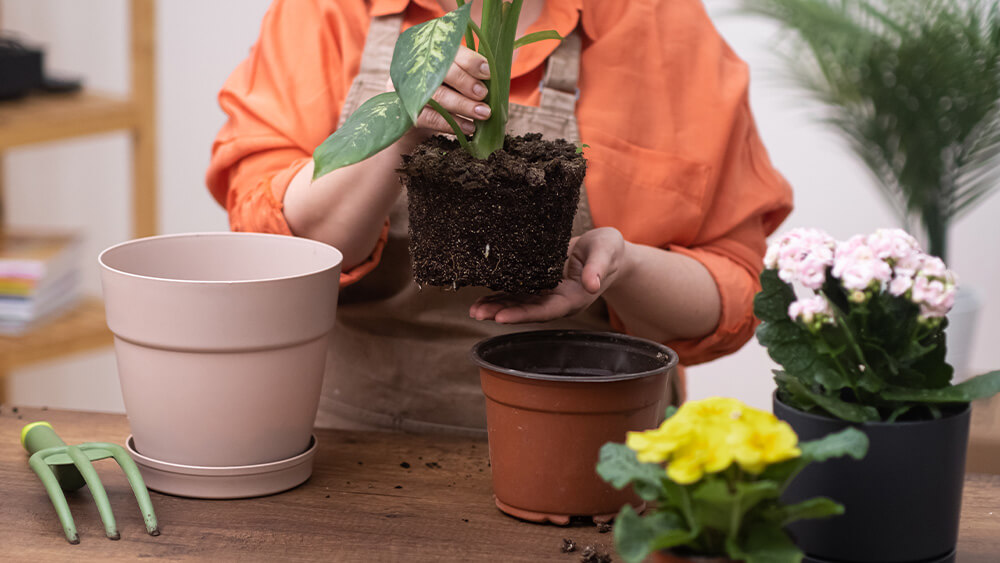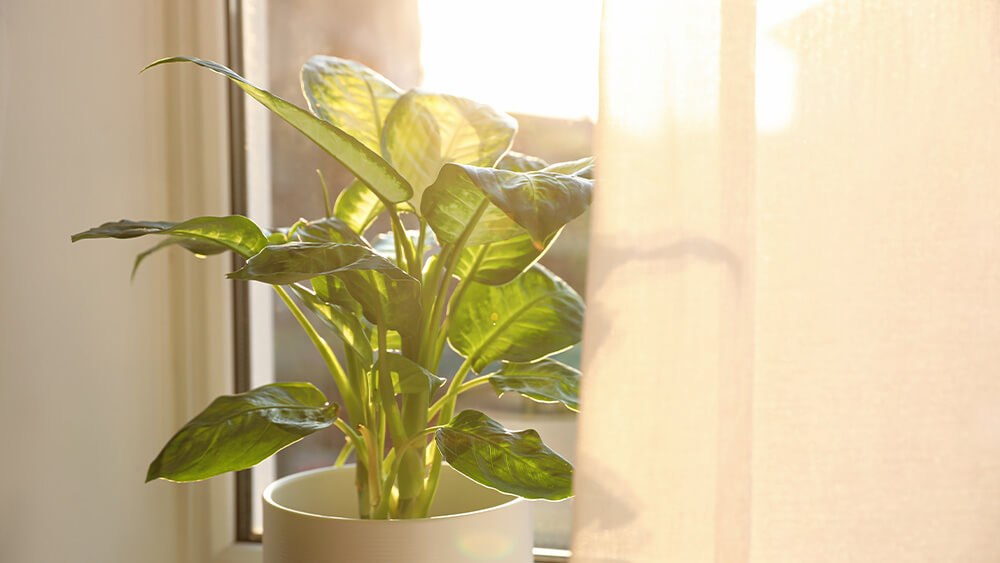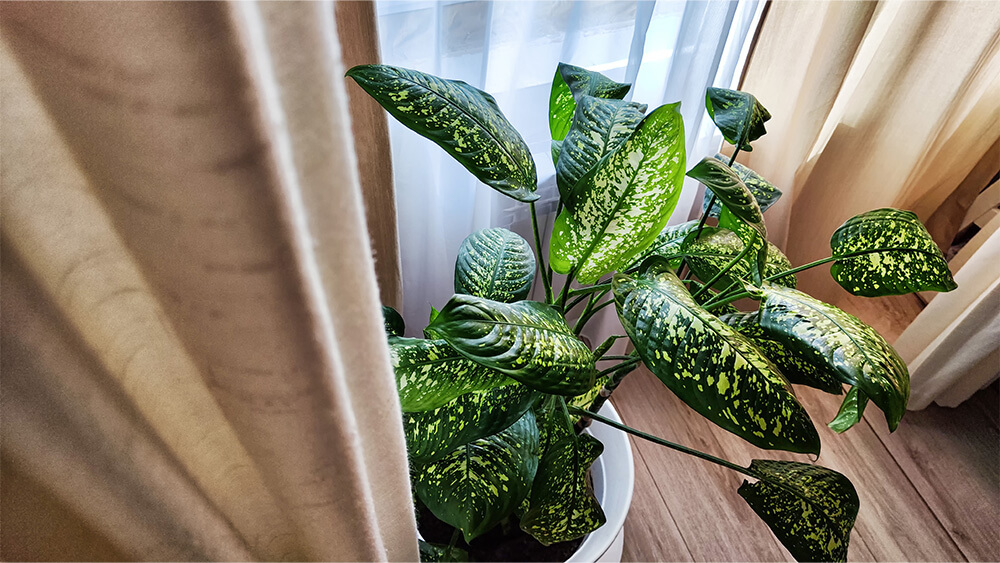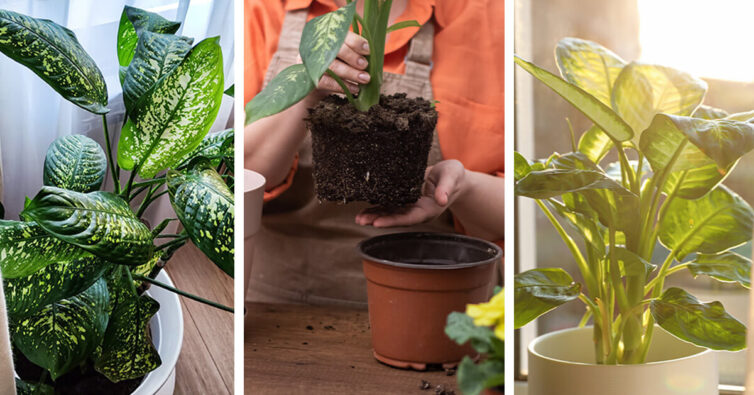A plant with a name sure to be a tongue twister, dieffenbachia, has far shorter nicknames, including dumb cane or leopard lily. Hailing from the New World Tropics, this species of plant is widely popular for ornamental indoor houseplants. Some of the Leopard Lily’s allure comes from the fact that it is shade tolerant, meaning it can grow in apartments, too.
Key Takeaways
- Dieffenbachia thrives in temperatures hovering around 68F.
- Dieffenbachias make a good beginner’s plant.
- The indoor dieffenbachia grows to be about 4 feet tall. Under ideal conditions, they may reach 6 feet tall with 20-inch leaves.
- Potting soil is better for Leopard Lillies than garden soil.
Discovering Dieffenbachia
For gardeners who do not want to replace plants every year, you’ll be happy to learn that this herbaceous plant is a perennial. It’s a rather simple sort, with alternate leaves with spots and flecks of different designs depending on the cultivar.
Heinrich Wilhelm Schott, the director of the Vienna Botanical Garden, named this plant. It honored Joseph Dieffenbach (1796-1863), the head gardener at Schonbrunn Palace in Vienna. The dumb cane is a member of the Arum family, being related to Jack in the Pulpit and Philodendron. Dieffenbachia makes a lovely accessory that brings large, rich green foliage into your home.
Dieffenbach is a toxic plant. It emits calcium oxalate crystals. When the crystal comes in contact with animals, it burns. In humans, it causes swelling. In fact, the name dumb cane came about because if you eat this plant, your mouth will swell up so much that you cannot speak. We do not recommend it for households with children or pets.
Due Diligence for Dieffenbachia Care
The Leopard Lily is thankfully a low-maintenance plant. The only time when you have to take extra care is when you prune them or try propagating. For your safety, wear garden gloves any time you’re caring for your indoor dieffenbachia.

Humidity
This plant likes it warm and humid. Place it on a tray of pebbles filled with water to increase the moisture in the air. Mist it regularly. Make sure you dust off the foliage every few weeks. The debris interferes with photosynthesis.
Light
When it comes to sunlight, look for a space in your home where the light coming in is bright but not direct. They can live in dimmer areas, but you won’t have the truly lush plant that so many people adore. Remember to rotate your plant so each side gets equal sun time.
Temperature
Dieffenbachia thieves in temperatures hovering between 60-80F. Watch for areas in your home with cold drafts (keep it away from air conditioning vents).
Water
Wet – nope. Dry – nope. Consistently moist soil is the key to a happy Dieffenbachia. If you’re not sure it’s watering time, use the finger test. Push down into two inches of the soil. If it’s dry, go ahead and water. Typically, a weekly watering in warm months does the trick, and every two weeks in colder months.
While Dieffenbachia is beautiful, some people used its toxic nature as punishment, specifically slaves. The head of the SS in Nazi Germany hoped to use the plant to sterilize prisoners. He couldn’t move forward because there was no way to ship them from Latin America.
Indoor Dieffenbachia Needs
While your plant isn’t very tall, the leaves on an indoor dieffenbachia can be 6” x 6”. This means you need to find a spot suited to their flowing leaf size and where they’re not crowded. Make sure the space has indirect sunlight for most of the day.
Look for a pot that’s larger than one-half the plant’s size and width. You want a container with drainage holes so water doesn’t pool around the Dieffenbachia’s roots. Once in place, if you have a humidifier in your home, place it near the plant to keep it healthy as possible. If you have a large bathroom, your Leopard Lilly will love it!
The main thing you want to avoid with this plant is over-watering. It needs constant moistness, not soggy soil.
Brazilian Beliefs: Folk tradition in Brazil claims dieffenbachia acts as an amulet of protection from negativity. They bring good fortune and success into a home, including money and abundance. Put one in the bedroom to improve your relationship.
A Plethora of Dieffenbachia for Your Home
The striking patterns and vibrant hues of green, white, cream, and yellow catch people’s eye. Nonetheless, they’re unpretentious plants. They agree with nearly any decor, offering elegance to the space. There are tons of cultivars for this plant, so do a little online surfing to see which one appeals to you. Here are a few you may like.

Camile: Camile has thin leaves with lime-colored centers. The edges of the leaf fade to white. Mature height: 3 feet. Leaf size: 12 inches, oval-shaped.
Camouflage: Light, bright green foliage with deeper colored vein lines. Dark splotches appear all over the leaves, which allude to the name. Mature height: nearly 4 feet. You need to be patient with this plant. It’s a slow grower producing only five leaves annually.
Compacta: Compacta resembles the Camile with midribs colored lightly, surrounded by dark green. Its leaves are pointy and can grow three feet long.
Carina: A lovely houseplant with leaves colored white or cream in the center, bordered by green. A smaller variety with a mature measurement of 15-20 inches. Carina is drought tolerant.
Daguensis: Displays large, broad emerald-green leaves with a lighter splotch dead center. Note only one side has the splotches. Very sensitive to drafts. Grows to about 3 feet tall.
Delilah: A larger indoor species (4.5 feet). The leaves have white patches in the center and spread out widely.
Honeydew: Honeydew is drought tolerant. The golden yellow leaves with green borders make this a distinctive dieffenbachia. You can expect a height of three feet, with 14” leaves.
Jewel: A very popular variety of dieffenbachia. Each 18-inch wide leaf features bold white variegation. To enjoy the full effect of Jewel, provide bright light to see a yellow lower leaf.
Panther: Panther is big and beautiful. The eight-inch leaves have green edges, white or cream spots, and dotted markings. Mature size: 3×3 feet.
Seguin: Sanguine has cane-like stems with creamy white leaves. The veined markings are pale yellow. It’s perfect for small spots growing only 1 foot tall. It’s a great choice for beginners.
Sterling: Sterling has bright white midribs from base to tip. This plant’s color remains vibrant year-round. They grow only a few inches a year, maturing at three feet tall.
Tropical Tiki: The large, decorative foliage on the Tiki takes up empty spaces in your home garden or walls. The leaves are light and dark green with creamy middle splotches.
Tropical Marianne: The leaves on this dieffenbachia are hosta-like. They have a cream texture and forest green border, which reach twelve inches at maturity. The plant itself may reach six feet.
Tropic Snow: Long variegated leaves, oblong green with hints of white and gold in the center. Leaves measure about five inches long, and the plant itself six feet.
White Etna: Broad, green leaves with tiny white dots sprinkled everywhere. Mature height: 3 feet.
In the best of circumstances, dieffenbachia can live for over 20 years. Some reach 40. It may well become a family heirloom.
Watering Dieffenbachia
Constant moisture is the key to a healthy Dieffenbachia. Boggy conditions lead to root rot. If you have an irrigation dish, empty it regularly. Keep a saucer filled with water and stones nearby. As the water evaporates, it puts moisture into the air. Mist your plant regularly, too.
Wait until the top inch of the soil is dry before watering. Water thoroughly. When water flowers out of the drainage hole, stop. Leave the soil to drain before putting it back in place. Adjust your watering schedules based on environmental conditions.
Terracotta Tips: Terracotta is a natural-looking accessory that’s earthy. This material is excellent for plants. Terracotta is porous. This means your plant’s roots can breathe. Additionally, terracotta has the capability of absorbing excess moisture, decreasing sogginess. Cactus and succulents appreciate terracotta, while ferns and mosses do not.
Potting and Repotting Dieffenbachia

When thinking about potting and repotting, one big consideration is a good soil mix. Regular garden soil won’t cut it. Most garden soils don’t drain well enough. Standard potting soil is better. You can add coconut coir with the potting soil to improve it for indoor gardens. Coconut improves drainage retention by about ten times its weight. Perlite is another alternative. It’s pieces of volcanic glass that create spaces between soil particles.
Before potting or repotting, grab your gloves. Put together the soil mixture. Fill the container about one-third of the way. Remove the plant from the greenhouse container or current pot. Gently pull at the base of the plant to release it.
Shake off excess soil from the roots. Place and transfer it to the center of the soil. Fill in around the plant with more soil until it reaches about one inch below the rim. Press down firmly. This removes air pockets. Give it a good watering and put it in bright, indirect light.
The Leopard Lily isn’t difficult to propagate. Just take a stem cutting, carefully avoiding the sap. You’re looking for a terminal end or lateral bud. Cut at least two inches, and let it dry out for 24 hours. Move the cutting into sand or sphagnum moss. Water them daily. Wait to move it into the soil until it has a thick bundle of roots.
Dieffenbachia Pruning and Maintenance
You don’t really have to prune a dumb cane. You can certainly trim out brown or shriveled leaves. If you have an exposed stem, clip that out too. Pruning keeps your plant tidy. It will be bushier and generally appear healthy.
How Big? Outdoors, dieffenbachia can grow upward of ten feet tall. Indoors, however, the best you’ll achieve is about six feet. The taller ones make excellent vertical features in the home. An average Leopard Lily plant won’t grow much larger than four feet.
Blooming and Resting Periods for Indoor Dieffenbachia
Indoor Dieffenbachia rarely develop flowers. If one pops up, it’s tiny, green, and creamy with a light earthy smell. Your plant may well slow in growth in cooler months (dormancy). You can reduce watering during these months.
Besides having luscious foliage and creating a stimulating visual for your indoor landscape, Dieffenbachia is healthy! It is among a group of houseplants proven to purify the air. It absorbs chemicals like toluene and xylene from the air. Some say keeping it near your bed improves sleep.
Common Pests & Plant Diseases
Like most plants, this plant is prone to certain issues:
- Spider Mites: Tiny sap-loving pests that create stippled leaves. Spider mites love warm, dry conditions. You’ll notice the telltale webbing in your plants. If you can increase humidity, that helps. Also, treat with insecticide or Neem Oil.
- Mealybugs: Cottony-looking insects that are also sap suckers. These, too, respond to insecticide and Neem.
- Scale: The first sign of scale is yellow leaves that fall off and an uptick in ant presence. Treat with insecticide.
- Root Rot: This fungus attacks the root because they’re waterlogged. Leaves will yellow and wilt, and the plant may die. Keep the soil well drained.
- Leaf Spot: A bacterial disease. It appears like water spots on the plant’s leaves. In the next stage, they turn brown or black. When you water your plant, keep it off the leaves. Use fungicide.
Dieffenbach varieties: If we’re talking about varieties vs. cultivars, there are about 30 Dieffenbach varieties in the world. Occasionally you’re rewarded with a long, green-white flower. It looks a bit like a Peace Lily.
Troubleshooting Common Problems
Browning Leaves: This one is tough. There could be too little or too much water. The lighting might be off, the temperature is erratic, or the plant may have a pest infestation. So a brief investigation is in order to narrow things down and then respond accordingly.
Curling Leaves: Often a sign of spider mites. You might be able to see them, but they leave behind little webs. A sturdy spray of water can knock them off. Follow up with Neem Oil.
Leggy Growth: Long stems with few leaves are called “leggy” in the plant world. Frequently, the problem is a lack of light. Moving it into a sunnier location might fix the problem fairly quickly. As an aside, Dieffenbachia gets leggy naturally with age.
Stunted Leaf Growth: Stunted leaf growth is one of the more common problems with Dieffenbachia. The main culprit is usually insect infestations. Bugs stress out plants. Treat the problem as soon as possible.
Yellow Stems: Yellow stems are a sign of over-watering. Moderate your watering schedule. Always water at the base.
In Brazil, people use the gargle as a root tincture and gout treatment. West Indies islanders use it to sterilize males for one to two days temporarily. The French Guiana’s healer’s kit includes this plant for ulcers.
Both Amerindians, Brazilians and the West Indies people use it as a component for poison arrows. Finally, in the Tropics, the seed oil goes on wounds, burns, and inflammation.
Summary
Dieffenbachia captures people’s attention. The impressive foliage with unique spots, lines, and some colors creates a striking element for the indoor garden. It’s easy to care for, and the seemingly limitless varieties from which to choose mean there’s one sure to please. Bring greenery indoors for mental health and beauty.


